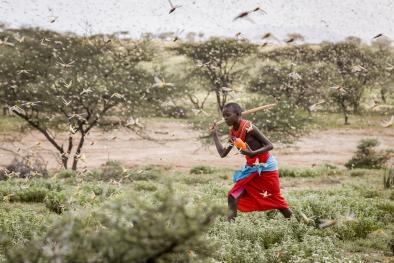Pakistan readies for second battle against crop-devouring locusts

Climate Signals Summary: Climate change is making extreme rainfall more common, like the heavy rains East Africa saw in 2019, which created the perfect breeding conditions for desert locusts. There is also growing evidence that climate change may be impacting an ocean circulation pattern known as the Indian Ocean Dipole, which can bring more frequent cyclones to the region, like the one that set the stage for the current locust crisis.
Article Excerpt: The United Nations' Food and Agriculture Organization (FAO) estimates losses to agriculture from locusts this year could be as high as PKR 353 billion ($2.2 billion) for winter crops like wheat and potatoes and about PKR 464 billion for summer crops.
A May update from the FAO warned it would be "imperative" to contain and control the desert locust infestation in the midst of the additional impacts of the COVID-19 pandemic on health, livelihoods, food security and nutrition for Pakistan's most poor and vulnerable communities.
Last year, Pakistan suffered its worst attack of locusts since 1993, for which the country was largely unprepared.
...
Mubarik Ahmed, national coordinator for locust control at FAO's office in Karachi, told the Thomson Reuters Foundation that Pakistan had been taken by surprise last year when locusts wreaked havoc in all its four provinces.
Unprecedented rains that led to vegetation cover in Sindh's Tharparkar desert had enabled the locusts to breed and then attack crop areas, he said.
...
Locust swarms are not new in East Africa, the Middle East and South Asia. But climate scientists say erratic weather linked to climate change has created ideal conditions for the insects to surge in numbers not seen in a quarter of a century.
Warmer seas have led to more cyclones in the Indian Ocean, causing heavy rainfall along the Arabian Peninsula and in the Horn of Africa, producing the perfect environment for breeding.
Experts say insect populations have found new homes across Pakistan and are now laying eggs in nearly 40% of its territory, including Sindh but mainly in the southwest province of Balochistan.
...
The swarms are expected to be much larger than in 2019, because their numbers increase on average 20-fold with each generation. They travel in swarms of between 30 million to 50 million insects, covering a distance of 150 km (93 miles) and devouring 200 tonnes of crops per day.



